Chinese mythology 中国神话传说 英文版的
中国神话传说英语
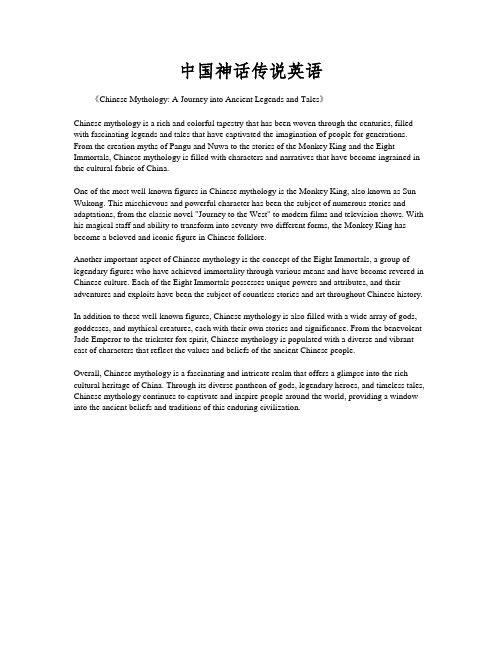
中国神话传说英语《Chinese Mythology: A Journey into Ancient Legends and Tales》Chinese mythology is a rich and colorful tapestry that has been woven through the centuries, filled with fascinating legends and tales that have captivated the imagination of people for generations. From the creation myths of Pangu and Nuwa to the stories of the Monkey King and the Eight Immortals, Chinese mythology is filled with characters and narratives that have become ingrained in the cultural fabric of China.One of the most well-known figures in Chinese mythology is the Monkey King, also known as Sun Wukong. This mischievous and powerful character has been the subject of numerous stories and adaptations, from the classic novel "Journey to the West" to modern films and television shows. With his magical staff and ability to transform into seventy-two different forms, the Monkey King has become a beloved and iconic figure in Chinese folklore.Another important aspect of Chinese mythology is the concept of the Eight Immortals, a group of legendary figures who have achieved immortality through various means and have become revered in Chinese culture. Each of the Eight Immortals possesses unique powers and attributes, and their adventures and exploits have been the subject of countless stories and art throughout Chinese history.In addition to these well-known figures, Chinese mythology is also filled with a wide array of gods, goddesses, and mythical creatures, each with their own stories and significance. From the benevolent Jade Emperor to the trickster fox spirit, Chinese mythology is populated with a diverse and vibrant cast of characters that reflect the values and beliefs of the ancient Chinese people.Overall, Chinese mythology is a fascinating and intricate realm that offers a glimpse into the rich cultural heritage of China. Through its diverse pantheon of gods, legendary heroes, and timeless tales, Chinese mythology continues to captivate and inspire people around the world, providing a window into the ancient beliefs and traditions of this enduring civilization.。
中国古代神话故事英文版

中国古代神话故事英文版Sure! Here is a brief introduction of two famous Chinese ancient mythological stories in English:1. "The Legend of Nüwa"In ancient Chinese mythology, it is believed that the world was once in chaos. Nüwa, a goddess with a human form and a serpent's tail, came to the world with the mission to create balance. She molded yellow clay into human figures, bringing them to life and establishing the human race. Nüwa also repaired the broken heavens, propping them up with stones to restore order. She is revered as the goddess of creation and restoration.2. "The Monkey King""The Monkey King," also known as "Journey to the West," is a renowned Chinese mythological tale. It follows the adventures of Sun Wukong, a mischievous and rebellious Monkey King endowed with incredible strength and magical abilities. Sun Wukong accompanies the monk Xuanzang on a pilgrimage to retrieve the sacred Buddhist scriptures from India. Along the journey, they encounter numerous challenges and face mythical creatures. Sun Wukong's bravery, intelligence, and loyalty make him a beloved and legendary character in Chinese mythology.These are just a glimpse of the vast collection of Chinese ancient mythological stories. They are filled with symbolism, cultural significance, and moral teachings, showcasing the rich imagination and beliefs of ancient Chinese civilization.。
中国古代神话英语版
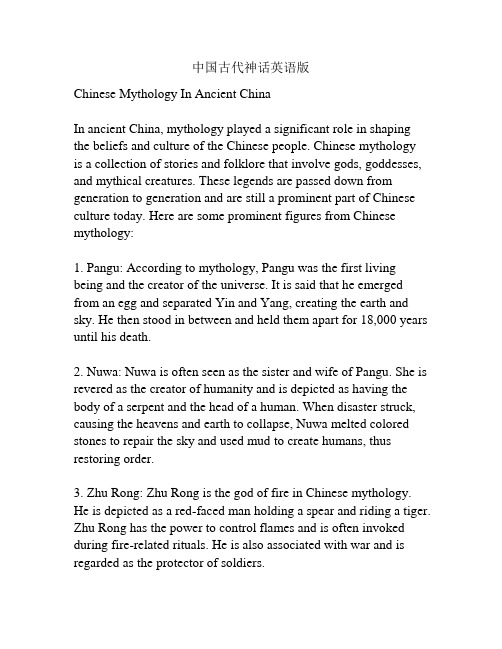
中国古代神话英语版Chinese Mythology In Ancient ChinaIn ancient China, mythology played a significant role in shaping the beliefs and culture of the Chinese people. Chinese mythologyis a collection of stories and folklore that involve gods, goddesses, and mythical creatures. These legends are passed down from generation to generation and are still a prominent part of Chinese culture today. Here are some prominent figures from Chinese mythology:1. Pangu: According to mythology, Pangu was the first living being and the creator of the universe. It is said that he emerged from an egg and separated Yin and Yang, creating the earth and sky. He then stood in between and held them apart for 18,000 years until his death.2. Nuwa: Nuwa is often seen as the sister and wife of Pangu. She is revered as the creator of humanity and is depicted as having the body of a serpent and the head of a human. When disaster struck, causing the heavens and earth to collapse, Nuwa melted colored stones to repair the sky and used mud to create humans, thus restoring order.3. Zhu Rong: Zhu Rong is the god of fire in Chinese mythology. He is depicted as a red-faced man holding a spear and riding a tiger. Zhu Rong has the power to control flames and is often invoked during fire-related rituals. He is also associated with war and is regarded as the protector of soldiers.4. Nüwa: Nüwa, also known as the mother goddess, is portrayed asa beautiful woman with the body of a snake. She is believed to have created humans out of clay and breathed life into them. Nüwa is also credited with repairing the pillars of heaven after they were damaged, preventing the sky from collapsing.5. Houyi: Houyi is a legendary archer who saved humanity from the ten suns that threatened to scorch the earth. He shot down nine suns, leaving only one in the sky, bringing relief to the people. Houyi is also associated with the myth of Chang'e, the goddess of the moon.These are just a few examples of the many gods, goddesses, and mythical beings from Chinese mythology. Each of these figures has their own unique stories and characteristics that have been ingrained in Chinese culture for centuries. The mythology continues to be a source of inspiration and fascination for people around the world who seek to learn more about ancient Chinese beliefs and folklore.。
中国神话英文版

3ห้องสมุดไป่ตู้
伏羲画卦
伏羲画卦
4
夸父逐日
夸父逐日
01.
1
In Chinese mythology, Kua Fu is known as the "runner" because he
tried to catch up with the sun and swallow it to save people from
4
on of Heaven for his efforts. The story of Da Yu's triumph over natural disaster is still told today as an inspiration for people to help each other in times of trouble
3
1
盘古开天地
5
盘古开天地
The story of Pan Gu is the creation myth of the Chinese people. It tells the story of how Pan Gu, the Creator, separated heaven and earth from chaos. With the help of the gods, he formed the world with his body. H
2
h had been built by Gun Long centuries earlier. Da Yu was a humble farmer who used his wits to solve this problem. He journeyed through the land and mountains to find a
中国神话故事英文版

中国神话故事英文版In Chinese mythology, there are countless fascinating stories that have been passed down through generations. These stories are filled with gods, goddesses, mythical creatures, and epic battles, offering a glimpse into the rich and colorful culture of ancient China. Today, let's explore some of the most famous Chinese mythologicalstories and legends, and delve into their English versions to share the magic and wonder with the world.One of the most well-known Chinese myths is the story of Nüwa and Fuxi, the creators of humankind. According to the legend, Nüwa, a goddess with a human's head and a serpent's body, and her brother Fuxi, a god with a human's head and a dragon's body, were the only two beings left after a great flood. They decided to create humans to keep each other company and to populate the earth. Nüwa and Fuxi used clay to mold the first humans, and from them, the human race was born. This myth explains the origin of humanity in Chinese culture and symbolizes the harmonybetween humans and nature.Another famous Chinese myth is the tale of the Monkey King, also known as Sun Wukong, from the classic novel "Journey to the West." Sun Wukong is a mischievous and powerful monkey who acquires incredible strength and magical abilities. He accompanies the Buddhist monk Tang Sanzang on a journey to retrieve sacred scriptures from India. Throughout their adventures, Sun Wukong displays his bravery, intelligence, and loyalty, making him one of the most beloved characters in Chinese literature. The story of the Monkey King has been adapted into various forms of media, including films, TV shows, and video games, and continues to captivate audiences around the world.The legend of Chang'e and Hou Yi is a romantic and tragic tale that is often associated with the Mid-Autumn Festival. According to the myth, Hou Yi was a skilled archer who saved the earth by shooting down nine of the ten suns that were scorching the land. As a reward, the Queen Mother of the West gave him the elixir of immortality. However, Hou Yi did not consume the elixir because he didnot want to live without his beloved wife, Chang'e. One day, Hou Yi's apprentice tried to steal the elixir, and in a desperate attempt to keep it out of his hands, Chang'edrank it and flew to the moon. Hou Yi was heartbroken and offered her favorite foods and fruits as a sacrifice, which eventually became the tradition of offering mooncakesduring the Mid-Autumn Festival.These are just a few examples of the captivating and enchanting stories that make up Chinese mythology. Eachtale is filled with symbolism, moral lessons, and cultural significance, offering a window into the beliefs and values of ancient China. Through their English versions, these myths can be shared and appreciated by people from allwalks of life, bridging the gap between cultures and celebrating the timeless beauty of Chinese folklore. As we continue to explore and preserve these stories, we honorthe rich heritage and legacy of Chinese mythology, ensuring that its magic and wonder will endure for generations to come.。
中国神话英文作文带翻译
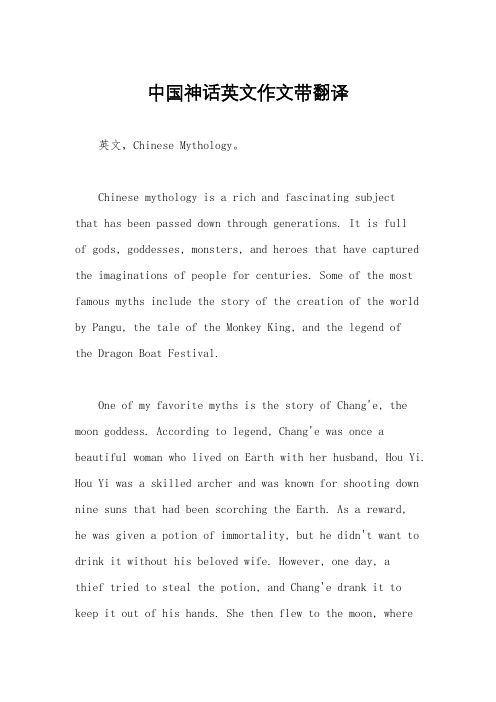
中国神话英文作文带翻译英文,Chinese Mythology。
Chinese mythology is a rich and fascinating subjectthat has been passed down through generations. It is fullof gods, goddesses, monsters, and heroes that have captured the imaginations of people for centuries. Some of the most famous myths include the story of the creation of the world by Pangu, the tale of the Monkey King, and the legend ofthe Dragon Boat Festival.One of my favorite myths is the story of Chang'e, the moon goddess. According to legend, Chang'e was once a beautiful woman who lived on Earth with her husband, Hou Yi. Hou Yi was a skilled archer and was known for shooting down nine suns that had been scorching the Earth. As a reward,he was given a potion of immortality, but he didn't want to drink it without his beloved wife. However, one day, athief tried to steal the potion, and Chang'e drank it to keep it out of his hands. She then flew to the moon, whereshe has lived ever since.Another interesting myth is the story of the White Snake. The White Snake was a powerful demon who fell in love with a mortal man named Xu Xian. She transformed herself into a beautiful woman and married him, but their happiness was short-lived when a Buddhist monk discovered her true identity. The monk tried to separate the couple, but the White Snake's love for Xu Xian was too strong. In the end, she sacrificed herself to save him from a flood, and her love was so pure that she was reborn as a human in her next life.中文,中国神话。
英文版中国神话故事
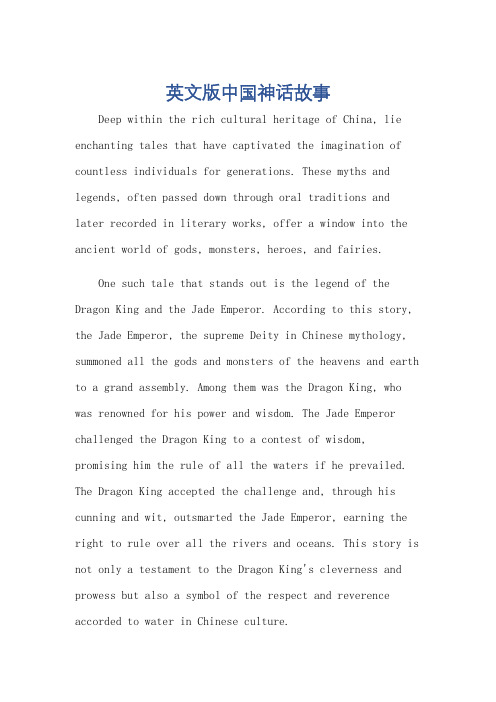
英文版中国神话故事Deep within the rich cultural heritage of China, lie enchanting tales that have captivated the imagination of countless individuals for generations. These myths and legends, often passed down through oral traditions andlater recorded in literary works, offer a window into the ancient world of gods, monsters, heroes, and fairies.One such tale that stands out is the legend of the Dragon King and the Jade Emperor. According to this story, the Jade Emperor, the supreme Deity in Chinese mythology, summoned all the gods and monsters of the heavens and earth to a grand assembly. Among them was the Dragon King, who was renowned for his power and wisdom. The Jade Emperor challenged the Dragon King to a contest of wisdom, promising him the rule of all the waters if he prevailed. The Dragon King accepted the challenge and, through his cunning and wit, outsmarted the Jade Emperor, earning the right to rule over all the rivers and oceans. This story is not only a testament to the Dragon King's cleverness and prowess but also a symbol of the respect and reverence accorded to water in Chinese culture.Another fascinating tale is the legend of Ne Zha, the god of war. According to legend, Ne Zha was born with a deformed body but possessed immense strength and courage. He was renowned for his bravery and became a general in the army of the Zhou dynasty, fighting valiantly against the oppressive Shang dynasty. His most famous feat was the conquest of the nine dragons, symbolizing the overthrow of the Shang dynasty's tyranny. Ne Zha's story is a powerful reminder of the importance of perseverance and courage in the face of adversity.The enchanted tales of ancient China are not just stories; they are areflection of the values, beliefs, and aspirations of the Chinese people. These myths and legends have been passed down through the ages, serving as a bridge between the past and the present, connecting generations of Chinese with their rich cultural heritage.These stories are often retold in modern times, notjust to preserve the cultural legacy but also to inspire and motivate people. The characters and themes from these myths and legends find their way into movies, books, andother forms of media, resonating with audiences across the globe.The enchanted tales of ancient China continue to captivate and inspire, serving as a reminder of the rich cultural heritage that has shaped the identity of the Chinese people. These myths and legends are not just stories; they are a part of our history, culture, andspirit.**中国古代神话故事的魅力**在中国丰富的文化遗产深处,隐藏着令人着迷的神话故事,这些故事代代相传,通过口头传统和文学作品记录下来,为无数人提供了探索古代神仙、怪兽、英雄和仙女世界的窗口。
中国神话故事英语版短篇
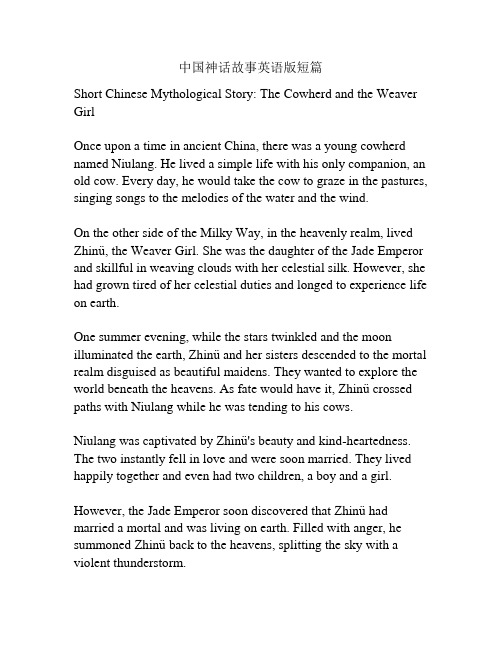
中国神话故事英语版短篇Short Chinese Mythological Story: The Cowherd and the Weaver GirlOnce upon a time in ancient China, there was a young cowherd named Niulang. He lived a simple life with his only companion, an old cow. Every day, he would take the cow to graze in the pastures, singing songs to the melodies of the water and the wind.On the other side of the Milky Way, in the heavenly realm, lived Zhinü, the Weaver Girl. She was the daughter of the Jade Emperor and skillful in weaving clouds with her celestial silk. However, she had grown tired of her celestial duties and longed to experience life on earth.One summer evening, while the stars twinkled and the moon illuminated the earth, Zhinü and her sisters descended to the mortal realm disguised as beautiful maidens. They wanted to explore the world beneath the heavens. As fate would have it, Zhinü crossed paths with Niulang while he was tending to his cows.Niulang was captivated by Zhinü's beauty and kind-heartedness. The two instantly fell in love and were soon married. They lived happily together and even had two children, a boy and a girl. However, the Jade Emperor soon discovered that Zhinü had married a mortal and was living on earth. Filled with anger, he summoned Zhinü back to the heavens, splitting the sky with a violent thunderstorm.Niulang returned home to find his wife and children gone. Overwhelmed by grief, he wept bitterly. The old cow, moved by his sadness, miraculously opened its mouth and spoke. It revealed to Niulang that one of its horns possessed magical powers and could bridge the gap between the mortal and celestial realms.With the cow's help, Niulang made a pair of magical ox-hide shoes, which allowed him to fly across the Milky Way. Determined to reunite with his wife, he embarked on a dangerous journey to the heavens.Niulang braved perilous rivers of stars and fierce storms, enduring countless challenges along the way. Finally, he reached the heavenly palace and found Zhinü beside a celestial river.Moved by Niulang's unwavering love, the Queen Mother of the West allowed the couple to reunite on the seventh day of the seventh lunar month each year. On this special day, magpies would form a bridge over the Milky Way, allowing Niulang, Zhinü, and their children to be together.And so, to this day, the Chinese people celebrate the Qixi Festival, also known as the Double Seventh Festival, as a testament to the enduring love between Niulang and Zhinü, the Cowherd and the Weaver Girl.Note: This is a short retelling of the Chinese mythological story known as "The Cowherd and the Weaver Girl" or "The Butterfly Lovers." The original story has various versions and interpretations, but this retelling captures its essence in a concise manner.。
中国神话故事英语版
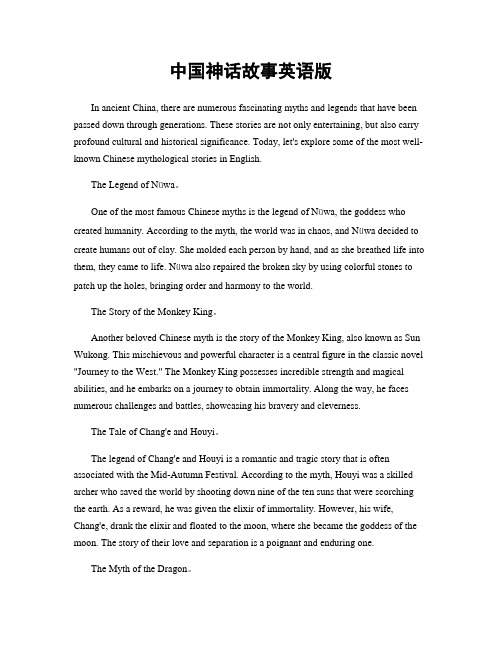
中国神话故事英语版In ancient China, there are numerous fascinating myths and legends that have been passed down through generations. These stories are not only entertaining, but also carry profound cultural and historical significance. Today, let's explore some of the most well-known Chinese mythological stories in English.The Legend of Nüwa。
One of the most famous Chinese myths is the legend of Nüwa, the goddess who created humanity. According to the myth, the world was in chaos, and Nüwa decided to create humans out of clay. She molded each person by hand, and as she breathed life into them, they came to life. Nüwa also repaired the broken sky by using colorful stones to patch up the holes, bringing order and harmony to the world.The Story of the Monkey King。
Another beloved Chinese myth is the story of the Monkey King, also known as Sun Wukong. This mischievous and powerful character is a central figure in the classic novel "Journey to the West." The Monkey King possesses incredible strength and magical abilities, and he embarks on a journey to obtain immortality. Along the way, he faces numerous challenges and battles, showcasing his bravery and cleverness.The Tale of Chang'e and Houyi。
女娲补天的神话故事英文版
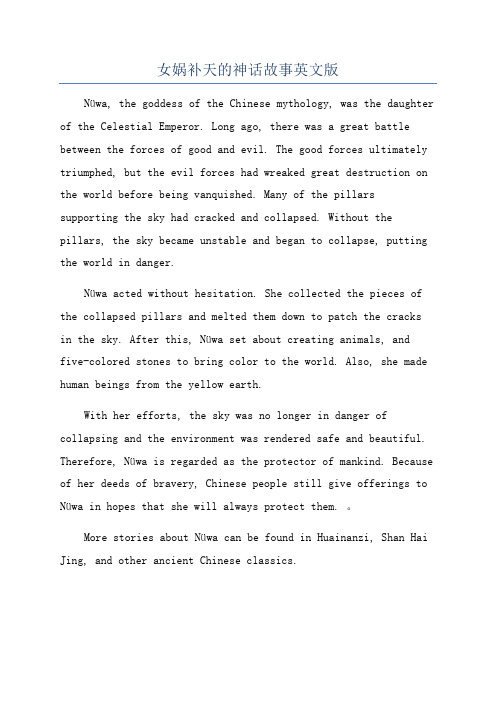
女娲补天的神话故事英文版Nüwa, the goddess of the Chinese mythology, was the daughter of the Celestial Emperor. Long ago, there was a great battle between the forces of good and evil. The good forces ultimately triumphed, but the evil forces had wreaked great destruction on the world before being vanquished. Many of the pillars supporting the sky had cracked and collapsed. Without the pillars, the sky became unstable and began to collapse, putting the world in danger.Nüwa acted without hesitation. She collecte d the pieces of the collapsed pillars and melted them down to patch the cracksin the sky. After this, Nüwa set about creating animals, andfive-colored stones to bring color to the world. Also, she made human beings from the yellow earth.With her efforts, the sky was no longer in danger of collapsing and the environment was rendered safe and beautiful. Therefore, Nüwa is regarded as the protector of mankind. Because of her deeds of bravery, Chinese people still give offerings to Nüwa in hopes that she wil l always protect them. 。
中国神话传说推荐作文英语
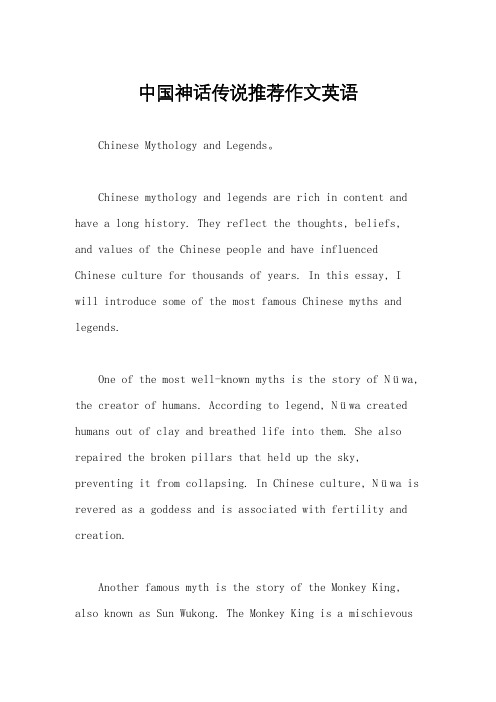
中国神话传说推荐作文英语Chinese Mythology and Legends。
Chinese mythology and legends are rich in content and have a long history. They reflect the thoughts, beliefs, and values of the Chinese people and have influenced Chinese culture for thousands of years. In this essay, I will introduce some of the most famous Chinese myths and legends.One of the most well-known myths is the story of Nüwa, the creator of humans. According to legend, Nüwa created humans out of clay and breathed life into them. She also repaired the broken pillars that held up the sky, preventing it from collapsing. In Chinese culture, Nüwa is revered as a goddess and is associated with fertility and creation.Another famous myth is the story of the Monkey King, also known as Sun Wukong. The Monkey King is a mischievousand powerful character who possesses incredible strengthand the ability to transform himself into different forms. He is the protagonist of the classic Chinese novel "Journey to the West" and is beloved by many Chinese people.The legend of the White Snake is another popular storyin Chinese mythology. The White Snake is a powerful andwise creature who falls in love with a mortal man. Together, they face many challenges and obstacles, including the disapproval of society and their own inner demons. Thisstory is often seen as a symbol of true love and the powerof perseverance.In addition to these myths and legends, there are many other fascinating stories in Chinese mythology. For example, the legend of the Dragon Boat Festival, the story of the Eight Immortals, and the myth of the Jade Emperor are all important parts of Chinese culture and history.In conclusion, Chinese mythology and legends are an integral part of Chinese culture and have played an important role in shaping the beliefs and values of theChinese people. These stories are not only entertaining but also offer valuable insights into the human experience and the mysteries of the universe.。
关于中国的神话故事英文
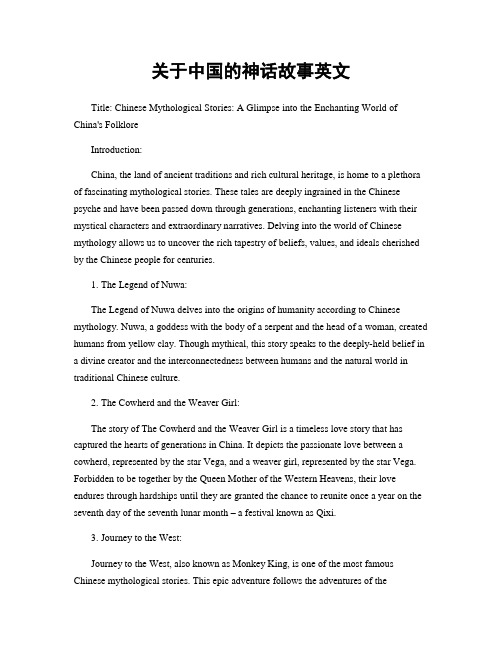
关于中国的神话故事英文Title: Chinese Mythological Stories: A Glimpse into the Enchanting World of China's FolkloreIntroduction:China, the land of ancient traditions and rich cultural heritage, is home to a plethora of fascinating mythological stories. These tales are deeply ingrained in the Chinese psyche and have been passed down through generations, enchanting listeners with their mystical characters and extraordinary narratives. Delving into the world of Chinese mythology allows us to uncover the rich tapestry of beliefs, values, and ideals cherished by the Chinese people for centuries.1. The Legend of Nuwa:The Legend of Nuwa delves into the origins of humanity according to Chinese mythology. Nuwa, a goddess with the body of a serpent and the head of a woman, created humans from yellow clay. Though mythical, this story speaks to the deeply-held belief in a divine creator and the interconnectedness between humans and the natural world in traditional Chinese culture.2. The Cowherd and the Weaver Girl:The story of The Cowherd and the Weaver Girl is a timeless love story that has captured the hearts of generations in China. It depicts the passionate love between a cowherd, represented by the star Vega, and a weaver girl, represented by the star Vega. Forbidden to be together by the Queen Mother of the Western Heavens, their love endures through hardships until they are granted the chance to reunite once a year on the seventh day of the seventh lunar month – a festival known as Qixi.3. Journey to the West:Journey to the West, also known as Monkey King, is one of the most famous Chinese mythological stories. This epic adventure follows the adventures of themischievous and brave Monkey King, Sun Wukong, as he accompanies the Buddhist monk, Xuanzang, on a perilous journey to retrieve sacred Buddhist texts from India. The story explores themes of friendship, loyalty, and the pursuit of spiritual knowledge.4. The Eight Immortals:The Eight Immortals is a captivating tale that revolves around a group of legendary figures who have achieved immortality through different means. Each immortal possesses unique powers and represents a specific virtue that resonates with Chinese values. This story symbolizes the pursuit of longevity, moral integrity, and spiritual growth.5. The Legend of Chang'e and Houyi:The Legend of Chang'e and Houyi is a timeless legend that explains the origin of the Mid-Autumn Festival, an essential annual celebration in Chinese culture. The story recounts the tale of Chang'e, a beautiful lunar goddess, and her husband, Houyi, a skilled archer. When Houyi obtains a pill of immortality, their world is forever changed, and Chang'e eventually finds solace on the moon. This tale beautifully captures themes of sacrifice, love, and the longing for reunion.Conclusion:Chinese mythological stories offer us a glimpse into the rich cultural heritage and belief systems of the Chinese people. Through these enchanting tales, we gain insight into their values, aspirations, and worldview. From stories of creation to epic adventures and tales of love and sacrifice, Chinese mythology invites us to explore a world filled with mythical creatures, gods, goddesses, and extraordinary heroes. The enduring popularity of these stories showcases their timeless appeal and the deep connections they forge between generations of Chinese people.。
中国神话故事英语作文

中国神话故事英语作文Chinese Mythological Story: The Legend of Chang'e and Hou Yi。
In ancient China, there was a beautiful and kind-hearted young woman named Chang'e. She was the wife of Hou Yi, a skilled archer known for his bravery and strength. The couple lived happily together, and their love for each other was the envy of all who knew them.One day, ten suns appeared in the sky, scorching the earth and causing great suffering to the people. In order to save the world, Hou Yi took up his bow and arrow and shot down nine of the suns, leaving only one to provide light and warmth for the earth. The people hailed him as a hero, and he became a legend in his own time.However, Hou Yi's fame and success went to his head, and he became arrogant and power-hungry. He began to seek immortality, believing that it would make him invincibleand all-powerful. He heard of a magical elixir that could grant eternal life, and he set out to find it.After a long and arduous journey, Hou Yi finally found the elixir in the form of a small pill. However, he knewthat he could not take it himself, as it was only enoughfor one person. He decided to give it to Chang'e, believing that she was his true love and deserved to live forever.Chang'e was deeply touched by Hou Yi's gesture, but she knew that immortality was not meant for mortals. She didnot want to live forever while her beloved husband grew old and died. So, instead of taking the elixir, she hid it away, fearing that it would bring disaster if it fell into the wrong hands.Unfortunately, word of the elixir spread, and soon, Hou Yi's apprentice, Peng Meng, learned of its existence. He coveted the power it would bring and plotted to steal it from Chang'e. One day, when Hou Yi was away, Peng Mengbroke into their home and demanded that Chang'e give himthe elixir. Fearing for her life, Chang'e swallowed theelixir before he could take it from her.As soon as she consumed the elixir, Chang'e felt her body becoming lighter and lighter, until she began to float into the air. She ascended to the moon, where she wouldlive for eternity as the Goddess of the Moon. Hou Yi was devastated when he learned what had happened, and he grieved for his lost love for the rest of his days.To this day, people in China celebrate the legend of Chang'e and Hou Yi during the Mid-Autumn Festival, also known as the Moon Festival. They offer sacrifices to the moon and eat mooncakes to commemorate the love andsacrifice of the legendary couple.The story of Chang'e and Hou Yi is a timeless tale of love, sacrifice, and the consequences of seeking power beyond what is meant for mortals. It serves as a reminder that true love and selflessness are more valuable than any earthly power or immortality.。
中国古代神话故事神农尝百草英文版
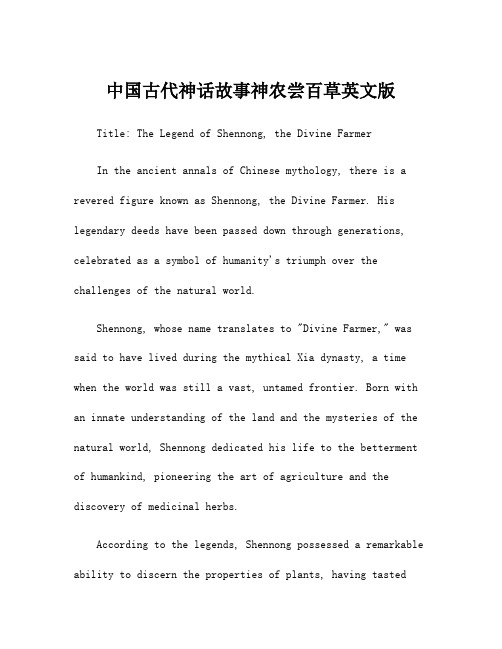
中国古代神话故事神农尝百草英文版Title: The Legend of Shennong, the Divine FarmerIn the ancient annals of Chinese mythology, there is a revered figure known as Shennong, the Divine Farmer. His legendary deeds have been passed down through generations, celebrated as a symbol of humanity's triumph over the challenges of the natural world.Shennong, whose name translates to "Divine Farmer," was said to have lived during the mythical Xia dynasty, a time when the world was still a vast, untamed frontier. Born with an innate understanding of the land and the mysteries of the natural world, Shennong dedicated his life to the betterment of humankind, pioneering the art of agriculture and the discovery of medicinal herbs.According to the legends, Shennong possessed a remarkable ability to discern the properties of plants, having tastedcountless herbs and flowers in his quest to uncover their hidden powers. He is often depicted with the head of an ox and the body of a human, a symbolic representation of his profound connection to the natural world.One of the most famous tales of Shennong's exploits involves his tireless exploration of the unknown. It is said that he traveled extensively, venturing into the depths of uncharted forests and scaling treacherous mountains in search of new and valuable plants. During these expeditions, he would meticulously sample each herb, carefully noting its effects on his own body.Through his unwavering dedication and selfless acts, Shennong is credited with discovering the healing properties of countless plants, including the now-renowned ginseng, ephedra, and ma-huang. These discoveries not only revolutionized traditional Chinese medicine but also laid the foundation for the development of modern pharmacology.In addition to his role as a master herbalist, Shennongis also revered as the inventor of the plough and the founder of agriculture in ancient China. Legend has it that he personally demonstrated the use of the plough to his fellow farmers, teaching them the techniques of tilling the soil and cultivating crops. This revolutionary act transformed the way people lived, allowing them to transition from a nomadic lifestyle to one of settled communities and prosperous agricultural settlements.Shennong's influence extends far beyond the boundaries of agriculture and medicine. He is also credited withintroducing the cultivation of the five staple grains – rice, millet, wheat, barley, and sorghum – which became the cornerstones of the Chinese diet and economy. This monumental achievement not only ensured the sustained nourishment of the people but also laid the groundwork for the development of a sophisticated food production system.As the story goes, Shennong's dedication to the well-being of his people was so profound that he even sacrificed his own life in the pursuit of knowledge. It is said that during one of his expeditions, he accidentally ingested a poisonous plant, which ultimately led to his demise. However, even in his final moments, Shennong remained unwavering in his commitment to his mission, recording his findings and bequeathing his discoveries to future generations.Today, Shennong is revered as a true hero of ancient China, a figure whose legacy continues to inspire and captivate people around the world. His unwavering spirit, his tireless exploration of the natural world, and his selfless dedication to the betterment of humanity have cemented his place as one of the most beloved and revered figures in Chinese mythology.。
中国神话故事英文版2分钟演讲
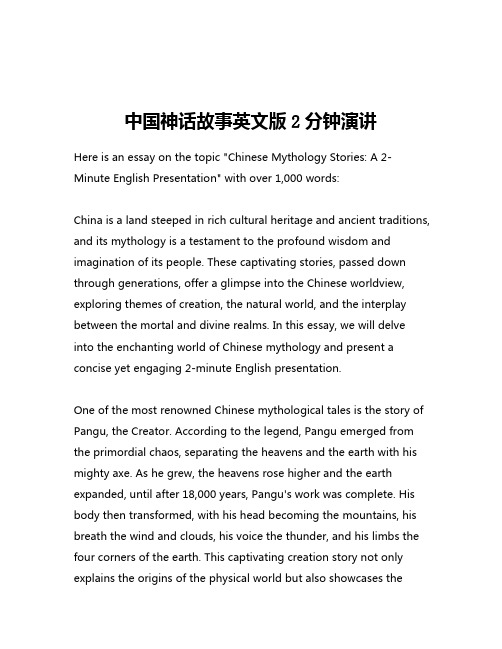
中国神话故事英文版2分钟演讲Here is an essay on the topic "Chinese Mythology Stories: A 2-Minute English Presentation" with over 1,000 words:China is a land steeped in rich cultural heritage and ancient traditions, and its mythology is a testament to the profound wisdom and imagination of its people. These captivating stories, passed down through generations, offer a glimpse into the Chinese worldview, exploring themes of creation, the natural world, and the interplay between the mortal and divine realms. In this essay, we will delve into the enchanting world of Chinese mythology and present a concise yet engaging 2-minute English presentation.One of the most renowned Chinese mythological tales is the story of Pangu, the Creator. According to the legend, Pangu emerged from the primordial chaos, separating the heavens and the earth with his mighty axe. As he grew, the heavens rose higher and the earth expanded, until after 18,000 years, Pangu's work was complete. His body then transformed, with his head becoming the mountains, his breath the wind and clouds, his voice the thunder, and his limbs the four corners of the earth. This captivating creation story not only explains the origins of the physical world but also showcases theChinese belief in the interconnectedness of all things.Another iconic figure in Chinese mythology is the Monkey King, also known as Sun Wukong. This mischievous and powerful deity embarks on a perilous journey to the West, accompanying the Buddhist monk Xuanzang on his quest to retrieve sacred scriptures. Along the way, the Monkey King battles demons, outwits tricksters, and demonstrates his unwavering loyalty and bravery. The tale of the Monkey King is a beloved classic that has been adapted into countless forms of media, from literature to film, and serves as a powerful symbol of Chinese cultural identity.The legend of the Jade Emperor, the supreme ruler of the heavens, is another integral part of Chinese mythology. This benevolent and just deity presides over the Celestial Palace, overseeing the affairs of the mortal realm and the workings of the natural world. The Jade Emperor's court is populated by a diverse array of immortal beings, each with their own unique powers and responsibilities, from the Four Celestial Kings who guard the four cardinal directions to the twelve Zodiac animals who govern the passage of time.One captivating myth that explores the relationship between the human and divine realms is the story of the Cowherd and the Weaving Maid. According to the legend, a young cowherd named Niu Lang and a celestial maiden named Zhi Nu fall in love and areforced to part ways when Zhi Nu's divine status is discovered. Heartbroken, the two lovers are allowed to meet only once a year, on the seventh day of the seventh lunar month, when a flock of magpies forms a bridge across the Milky Way to reunite them. This poignant tale of star-crossed lovers has become a beloved symbol of enduring love and the power of human-divine connection.These are just a few examples of the rich tapestry of Chinese mythology, each story brimming with vivid imagery, complex characters, and profound themes that have resonated with audiences for centuries. Through these tales, we can gain a deeper understanding of the Chinese worldview, which values harmony, balance, and the interconnectedness of all things. By sharing these captivating myths with a global audience, we can foster a greater appreciation for the cultural richness and enduring wisdom of the Chinese civilization.In conclusion, the realm of Chinese mythology is a treasure trove of captivating stories that offer a window into the unique perspectives and beliefs of the Chinese people. From the grand creation of the universe to the intimate tales of love and loss, these myths continue to inspire and captivate audiences around the world. By engaging with these timeless narratives, we can deepen our understanding of the Chinese cultural heritage and cultivate a greater appreciation for the enduring power of storytelling.。
有趣的中国神话故事-女娲补天(中、英文版)

女娲补天根据传说,古代天空有十个太阳同时升起,炙烤大地,给人间带来了巨大的灾难。
为了拯救人类和其他生物,女娲决定采取行动。
她找到一根巨大的石柱和一块宝石,用宝石做成了一把尖锐的斧子。
女娲开始登上高山,挥舞着斧子朝天空砍击。
她用巨大的力量将石柱击入大地,然后把它变成了一根支撑天空的柱子。
随后,她爬上柱子,精心选择美丽的五色石块,把它们磨碎成粉末,撒向天空,使其变得五彩斑斓。
女娲的努力成功地修复了天空,将十个太阳都收了起来,恢复了人间的和平与生机。
她的伟大举动被人们永远铭记,女娲也成为了人们崇拜的神灵之一。
以下是女娲补天的故事的英文版:The Story of Nüwa Mending the SkyAccording to Chinese mythology, there was a story about Nüwa mending the sky, where she used a magical method to repair the heavens.In ancient times, there were ten suns that rose in the sky simultaneously, scorching the earth and bringing great disasters to mankind. In order to save humanity and other creatures, Nüwa decided to take action. She found a massive pillar and a precious gem, using the gem to forge a sharp axe.Nüwa ascended a high mountain and swung the axe toward the sky.With tremendous force, she drove the pillar into the earth, transforming it into a support for the heavens. Afterwards, she climbed onto the pillar and carefully selected beautiful multicolored stones, grinding them into powder and scattering them across the sky, creating a splendid display of colors.Through Nüwa's efforts, the sky was successfully repaired, and the ten suns were all brought under control, restoring peace and vitality to the world. Her great feat was forever remembered by the people, and Nüwa became one of the revered deities.。
中国神话英文故事作文
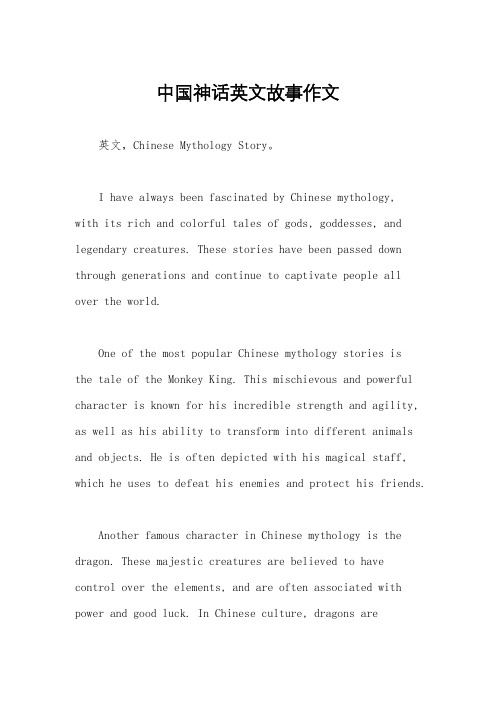
中国神话英文故事作文英文,Chinese Mythology Story。
I have always been fascinated by Chinese mythology,with its rich and colorful tales of gods, goddesses, and legendary creatures. These stories have been passed down through generations and continue to captivate people all over the world.One of the most popular Chinese mythology stories isthe tale of the Monkey King. This mischievous and powerful character is known for his incredible strength and agility, as well as his ability to transform into different animals and objects. He is often depicted with his magical staff, which he uses to defeat his enemies and protect his friends.Another famous character in Chinese mythology is the dragon. These majestic creatures are believed to havecontrol over the elements, and are often associated with power and good luck. In Chinese culture, dragons arerevered and respected, and are often depicted in art and literature.In addition to these well-known characters, Chinese mythology is full of other fascinating figures, such as the goddess Guanyin, who is revered for her compassion and mercy, and the legendary creature known as the qilin, which is said to bring good fortune and happiness.中文,中国神话故事。
有趣的中国神话故事-女娲造人(中、英文版)
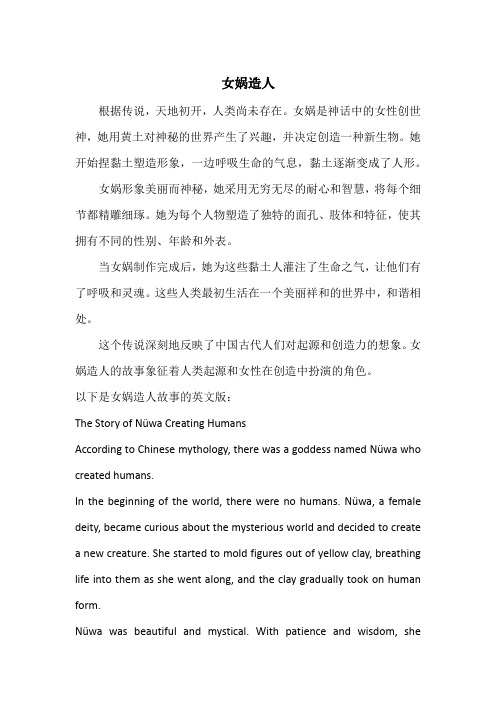
女娲造人根据传说,天地初开,人类尚未存在。
女娲是神话中的女性创世神,她用黄土对神秘的世界产生了兴趣,并决定创造一种新生物。
她开始捏黏土塑造形象,一边呼吸生命的气息,黏土逐渐变成了人形。
女娲形象美丽而神秘,她采用无穷无尽的耐心和智慧,将每个细节都精雕细琢。
她为每个人物塑造了独特的面孔、肢体和特征,使其拥有不同的性别、年龄和外表。
当女娲制作完成后,她为这些黏土人灌注了生命之气,让他们有了呼吸和灵魂。
这些人类最初生活在一个美丽祥和的世界中,和谐相处。
这个传说深刻地反映了中国古代人们对起源和创造力的想象。
女娲造人的故事象征着人类起源和女性在创造中扮演的角色。
以下是女娲造人故事的英文版:The Story of Nüwa Creating HumansAccording to Chinese mythology, there was a goddess named Nüwa who created humans.In the beginning of the world, there were no humans. Nüwa, a female deity, became curious about the mysterious world and decided to create a new creature. She started to mold figures out of yellow clay, breathing life into them as she went along, and the clay gradually took on human form.Nüwa was beautiful and mystical. With patience and wisdom, shemeticulously crafted each detail. She gave every figure a unique face, body, and features, ensuring that they had different genders, ages, and appearances.After Nüwa finished creating the clay figures, she infused them with the breath of life, giving them the ability to breathe and souls of their own. These humans initially lived in a beautifully harmonious world, coexisting peacefully.This legend reflects the ancient Chinese imagination about origins and creativity. The story of Nüwa creating humans symbolizes the origin of humanity and the role of women in creation.。
中国神话(英语版)
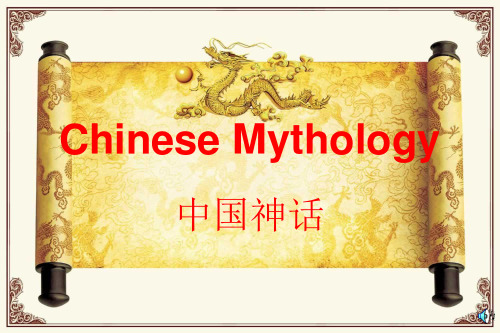
三皇(Three Emperors): 伏羲, 神农, 女娲
五帝 (Five Sovereigns):常指黄帝、 颛顼、帝俊、尧、舜
四大天王:增长天王 、持国天王 、 多闻天王 、广目天王
• four Heavenly Kings
the Eight Immortals 八仙
• 铁拐李(李玄/李洪水)、汉钟离(钟离权)、张果老、 蓝采和、何仙姑(何晓云)、吕洞宾(吕岩)、韩湘子、 曹国舅(曹景休)。
道祖:老子(太上老君the very high lord)
the God of Wealth 财神赵公明
the God of Longevity 寿星南极仙翁
symbols in chinese ancient myths
• The dragon is the repersentative of the chinese nation, it is the symbol of China.
凤凰(Phoenix Red)
• Phoenix is on behalf of woman, it is the auspicious sign you for your attention.
•
2,the main works of chinese mythology中国神话的基本典籍
• ancient books古籍:
Shanhijing《山海经》The songs of Chu《楚辞 》 Tianwen《天问》 Huainanzi 《淮南子》 The Book of Songs《诗经》Mandarin《国语》 The commentary of Zuo《左传》 Zhuangzi《庄子》 Liezi《列子》等先秦古籍、 纬书
- 1、下载文档前请自行甄别文档内容的完整性,平台不提供额外的编辑、内容补充、找答案等附加服务。
- 2、"仅部分预览"的文档,不可在线预览部分如存在完整性等问题,可反馈申请退款(可完整预览的文档不适用该条件!)。
- 3、如文档侵犯您的权益,请联系客服反馈,我们会尽快为您处理(人工客服工作时间:9:00-18:30)。
Chinese MythologyChinese mythology (中国神话) is a collection of cultural history, folktales, and religions that have beenpassed down in oral or written tradition. These include creation myths and legends and myths concerning the founding of Chinese culture and the Chinese state. Like many mythologies, it has in the past been believed to be, at least in part, a factual recording of history.Historians have conjectured that the Chinese mythology began in the 12th century BCE. The myths and legends were passed down in oral form for over a thousand years, before being written in books such as Shan Hai Jing. Other myths continued to be passed down through oral traditions like theater and song, before being recorded as novels such as Hei'an Zhuan - Epic of Darkness (literally Epic of the Darkness). This collection of epic legends is preserved by a community of Chinese Han nationality, inhabitants of the Shennongjia mountain area in Hubei, and contains accounts from the birth of Pangu up to the historical era.Imperial historical documents and philosophical canons such as Shangshu, Shiji, Liji, Lüshi Chunqiu, and others, all contain Chinese myths.Creation mythsChinese creation myths explain the legendary beginnings of the universe, earth, and life.Early Chinese texts recorded fragments of creation stories. The Zhuangzi and Huainanzi cosmogonically mention Hundun. The Shujing and Guoyu describe the separation of Heaven and Earth during the legendary era of Zhuanxu. The Huainanzi and Chuci say that Nüwa created the first humans from yellow clay and repaired the fallen pillars of Heaven (cf. Axis mundi).One of the most popular creation myth in Chinese mythology describes Pangu 盤古separating the world egg-like Hundun 混沌"primordial chaos" into Heaven and Earth. However, none of the ancient Chinese classics mentions the Pangu myth, which was first recorded in the (3rd century CE) Sanwu Liji三五歴記"Record of Cycles in Threes and Fives", written by Three Kingdoms period Daoist author Xu Zheng. Derk Bodde paraphrases.Heaven and Earth were once inextricably commingled (hun-tun) like a chicken's egg, within which was engendered P'an-ku (a name perhaps meaning "Coiled-up Antiquity"). After 18,000 years, this inchoate mass split apart, what was bright and light forming Heaven, and what was dark and heavy forming Earth. Thereafter, during another 18,000 years, Heaven daily increased ten feet in height, Earth daily increased ten feet in thickness, and P'an-ku, between the two, daily increased ten feet in size. This is how Heaven and Earth came to be separated by their present distance of 9 million li (roughly 30,000 English miles). (1961:382-3)The (ca. 4th century BCE) Daodejing suggests a less mythical Chinese cosmogony and has some of the earliest allusions to creation.There was something featureless yet complete, born before heaven and earth; Silent – amorphous – it stood alone and unchanging. We may regard it as the mother of heaven and earth. Not knowing its name, I style it the "Way." (tr. Mair 1990:90)The Way gave birth to unity, Unity gave birth to duality, Duality gave birth to trinity, Trinity gave birth to the myriad creatures. The myriad creatures bear yin on their back and embrace yang in their bosoms. They neutralize these vapors and thereby achieve harmony. (tr. Mair 1990:9)Later Daoists interpreted this sequence to mean the Dao "Way", formless Wuji "Without Ultimate", unitary Taiji "Great Ultimate", and binary yin and yang or Heaven and Earth.The (ca. 4th-3rd centuries BCE) Taiyi Shengshui "Great One gave birth to water", a Daoist text recently excavated in the Guodian Chu Slips, offers an alternate creation myth, but analysis remains uncertain.The (ca. 120 CE) Lingxian靈憲, by the polymath Zhang Heng, thoroughly accounts for the creation of Heaven and Earth.Before the Great Plainness (or Great Basis, Taisu 太素) came to be, there was dark limpidity and mysterious quiescence, dim and dark. No image of it can be formed. Its midst was void; its exterior was non-existence. Things remained thus for long ages; this is called obscurity (mingxing溟涬). It was the rootof the Dao. … When the stem of the Dao had been grown, creatures ca me into being and shapes were formed. At this stage, the original qi split and divided, hard and soft first divided, pure and turbid took up different positions. Heaven formed on the outside, and Earth became fixed within. Heaven took it body from the Yang, so it was round and in motion; Earth took its body from the Yin, so it was flat and quiescent. Through motion there was action and giving forth; through quiescence there was conjoining and transformation. Through binding together there was fertilization, and in time all the kinds of things werebrought to growth. This is called the Great Origin (Taiyuan 太元). It was the fruition of the Dao. (tr. Cullen 2008:47)The Neo-Confucianist philosopher Zhou Dunyi provided a multifaceted cosmology in his Taiji tushuo太極圖說"Diagram Explaining the Supreme Ultimate", which integrated the Yijing with Daoism and Chinese Buddhism.Zhou's Taiji tushuo diagramMajor concepts and figuresSome myths survive in theatrical or literary formats, as plays or novels. Important mythological fiction which is seen as definitive records of these myths include:•Verse poetry of ancient states such as Lisao by Qu Yuan of the Chu state.•Fengshen Bang (封神榜), or Investiture of the Gods, a mythological fiction dealing with the founding of the Zhou dynasty.•Journey to the West, by Wu Cheng'en and published in the 1590s, a fictionalised account of the pilgrimage of Xuanzang to India to obtain Buddhist religious texts, in which the pilgrims encounter ghosts, monsters, and demons as well as the Flaming Mountains.•Baishe Zhuan, a romantic tale set in Hangzhou involving a female snake who attained human form and fell in love with a man.Shangdi (上帝)Shangdi (上帝, pinyin: Shàngdì, Wade-Giles Shang Ti, lit. "High Sovereign") refers to a god or a powerregarded as the spiritual ultimate by the Chinese people during the Shang Dynasty.[1] According to Yanxia Zhao, evidence shows that Shangdi was probably more transcendental than immanent, only workingthrough lesser gods.[2] During the Zhou Dynasty, Shangdi was associated with Heaven (天Tiān).[3] By thetime of the Han dynasty, the influential Confucian scholar Zheng Xuan declared that "Shangdi is another name for Tian." Shangdi remains chiefly synonymous with Heaven in modern Chinese thought.First mentionThe earliest references to Shangdi are found in Oracle Bone inscriptions of the Shang Dynasty (ca. 1600 –ca. 1046 BC). Shangdi is first mentioned in Chinese Literature in the Five Classics, allegedly compiled by Confucius in the 6th century BC. The Wujing was a collection of five books that represented the pinnacle of Chinese culture at that time. The oldest parts of the Wujing were first written around 1000 BC, apparently relying on older texts. All of the five classics include references to Shangdi:Occurrences of Shangdi (上帝) in Wujing (五經)char pinyin English occurrence書經 Shujing Classic of History 32 times詩經 Shijing Classic of Poetry 24 times禮記 Liji Classic of Rites 20 times春秋 Chunqiu Spring and Autumn Annals 8 times易經 Yijing Classic of Changes 2 timesOther classics mention Shangdi as well. Another "Classic" collection, the Four Books (四書, pinyin: SìShū), mentions Shangdi also, but it is a later compilation and the references are much more sparse andabstract. The highest number of occurrences appear in the earliest references; this pattern may reflect increasing rejection of Shangdi over time.One of the five books in the Wujing is the Classic of History, (書經, pinyin: Shujing), aka Book of History, aka Esteemed Book (尚書, pinyin: Shangshu). The Shujing is possibly the earliest narrative of China, andmay predate the European historian Herodotus (about 440 BC) as a history by many centuries. This implies that Shangdi is the oldest deity directly referenced by any Chinese narrative literature. The Shujing itself is also divided into 5 parts, and those parts were actually considered books as well. However, the number of books or "documents" is a division that varies depending on the version or compilation. Therefore, quoted references may not match in different compilations.The 2nd of the 5 "books" inside the Shujing is called the "Book of Yu" (虞書, pinyin: Yushu). Yu, in this title, is a location, not the popular hero Yu (禹). This "book" has 4 "chapters"; and the 1st "chapter" is called the "Canon of Shun" (舜典, pinyin: Shun Dian). Emperor Shun was the predecessor to the heroic Da Yu (大禹), or Great Yu, the first emperor of the Xia Dynasty. About the third sentence is the first mentionof Shangdi. And, as it was mentioned in the previous section how yearly sacrifices to Shangdi were made by Emperor Shun, the Chinese belief in Shangdi may have been regarded as predating the Xia Dynasty.WorshipFrom the earliest eras of Chinese history, Shangdi was officially worshipped through sacrificial rituals. Shangdi is believed to rule over natural and ancestral spirits, who act as His ministers. Shangdi is thought to be the Supreme Guide of both the natural order and the human order. The ruler of China in every Chinese dynasty would perform annual sacrificial rituals to Shangdi at the great Temple of Heaven in the imperial capital. During the ritual a completely healthy bull would be slaughtered and presented as an animal sacrifice to Shangdi. It is important to note that Shangdi is never represented with either images or idols. Instead, in the center building of the Temple of Heaven, in a structure called the "Imperial Vault ofHeaven", a "spirit tablet" (神位, or shénwèi) inscribed with the name of Shangdi is stored on the throne,Huangtian Shangdi (皇天上帝). During an annual sacrifice, the emperor would carry these tablets to thenorth part of the Temple of Heaven, a place called the "Prayer Hall For Good Harvests", and place them on that throne.[4]Jade Emperor)Jade Emperor in a Ming Dynasty ink and color painting on silk, 16th century.The Jade Emperor (Chinese: 玉皇; pinyin: Yù Huáng or 玉帝Yù Dì) in Chinese folk culture, is the rulerof Heaven and all realms of existence below including that of Man and Hell, according to a version of Taoist mythology. He is one of the most important gods of the Chinese traditional religion pantheon. In actual Taoism, the Jade Emperor governs all of the mortals' realm and below, but ranks below the Three Pure Ones.The Jade Emperor is known by many names, including Heavenly Grandfather (天公Tiān Gōng) which is used by commoners; the Pure August Jade Emperor, August Personage of Jade (玉皇上帝Yu Huang Shangdi or 玉皇大帝Yu Huang Dadi); the Xuanling High Sovereign; and his rarely used, formal title, Peace Absolving, Central August Spirit Exalted, Ancient Buddha, Most Pious and Honorable, His Highness the Jade-Emperor, Xuanling High Sovereign (太平普度皇靈中天至聖仁義古佛玉皇大天尊).There are many stories in Chinese mythology involving the Jade Emperor.OriginIt was said that the Jade Emperor was originally the crown prince of the kingdom of Pure Felicity and Majestic Heavenly Lights and Ornaments. At birth, he emitted a wondrous light that filled the entire kingdom. When he was young, he was kind, intelligent and wise. He devoted his entire childhood to helping the needy (the poor and suffering, the deserted and single, the hungry and disabled). Furthermore, he showed respect and benevolence to both men and creatures. After his father died, he ascended the throne. He made sure that everyone in his kingdom found peace and contentment. After that, he told his ministers that he wished to cultivate Tao on the Bright and Fragrant Cliff.After 1,550 kalpas, each kalpa lasting for 129,600 years, he attained Golden Immortality. After another one hundred million years of cultivation, he finally became the Jade Emperor. (Using the given figures, this period before his becoming the Jade Emperor lasted for a total of about 200,880,000 years.)Vanquishing evilOne of the myths describes how the Jade Emperor became the monarch of all the deities in heaven. It is one of the few myths in which the Jade Emperor really shows his might.In the beginning of time, the earth was a very difficult place to live; a much harsher place to live in than itis now. People were having tremendous difficulty coping with existence; not only did they have to deal with harsh conditions, but also with all kinds of monstrous beings. At this time, there were also not many gods or deities to protect them. Furthermore, a lot of powerful, evil demons were defying the immortals of heaven. The Jade Emperor was still at the time an ordinary immortal who roamed earth to help as many people as he could. He was, however, saddened by the fact that his powers were limited and could onlyease the sufferings of humans. He decided to retreat in a mountain cave and cultivate his Tao. He passed 3,200 trials, each trial lasting about 3 million years.Unfortunately, a powerful, evil entity—a demon of sorts, which dwelt on earth—had the ambition to conquer the immortals and gods in heaven and proclaim sovereignty over the entire universe. This evil entity also went into retreat and meditation to expand its power, though later than the Jade Emperor. He passed through 3,000 trials each trial lasting for about 3 million years too. After it passed its final trial, it felt confident that no one could defeat it anymore. It re-entered the world again, and recruited an army of demons with the purpose of attacking heaven.The immortals, being aware of the threat, gathered themselves and prepared for war. The gods were unable to stop the powerful demon and it defeated them all.Fortunately, the Jade Emperor finished his cultivation in the midst of this war. He was changing the land to make it more liveable for men and repelling all kinds of monstrous beasts. Suddenly, he saw an evil glow emitting from heaven and knew something was amiss. He ascended and saw that a war was going on, he saw that the demon was too powerful to be stopped by any of the gods present. He went up and challenged the demon, and a battle ensued between them. Mountains shook and rivers and seas toppled; however, the Jade Emperor stood victorious due to his deeper and wiser cultivation, not for might but for benevolence. After defeating the demon, all the other demons were scattered by the gods and immortals.Because of his noble and benevolent deeds, the gods, immortals and humans proclaimed the Jade Emperor the supreme sovereign of all.CreationJade EmperorThe world started with 無極(wuji: nothingness) according to the Chinese creation myth, Jade Emperor was the head of the pantheon but not responsible to the creation process itself.According to another version of creation myth, the Jade Emperor fashioned the first humans from clay, but as he left them to harden in the sun, it rained, misshaping some of the figures, thus explaining the origin of sickness and physical abnormalities (The most common alternative Chinese creation myth states that human beings were once fleas on the body of Pangu.)The story above is also told as Nüwa, who fashions evil out of the mud from the Yellow River by hand. Those she made became the richer people of the earth. After getting lazy, she used a rope and swung it around. The drops that fell from the rope became the poorer humans.The princess and the cowherdIn another story[citation needed], popular throughout Asia and with many differing versions, the Jade Emperor has a daughter named Zhinü (simplified Chinese: 织女; traditional Chinese: 織女; pinyin: zhī nǚ orChih'nü, literally: weaver girl). She is most often represented as responsible for weaving colorful clouds in the heaven. In some versions she is the Goddess Weaver, daughter of the Jade Emperor and the Celestial Queen Mother, who weaves the Silver River (known in the West as the Milky Way), which gives light to heaven and earth. In other versions, she is a seamstress who works for the Jade Emperor.Every day Zhinü descended to earth with the aid of a magical robe to bathe. One day, a lowly cowherd named Niu Lang (Chinese: 牛郎; pinyin: niú láng) spotted Zhinü as she bathed in a stream. Niu Lang fellinstantly in love with her and stole her magic robe which she had left on the bank of the stream, leaving her unable to escape back to Heaven. When Zhinü emerged from the water, Niu Lang grabbed her and carried her back to his home.When the Jade Emperor heard of this matter, he was furious but unable to intercede, since in the meantime his daughter had fallen in love and married the cowherd. As time passed, Zhinü grew homesick and began to miss her father. One day, she came across a box containing her magic robe which her husband had hidden. She decided to visit her father back in Heaven, but once she returned, the Jade Emperor summoned a river to flow across the sky (the Milky Way), which Zhinü was unable to cross to return to her husband. The Emperor took pity on the young lovers, and so once a year on the seventh day of the seventh month of the lunar calendar, he allows them to meet on a bridge over the river.The story refers to constellations in the night sky. Zhinü is the star Vega in the constellation of Lyra east of the Milky Way, and Niu Lang is the star Altair in the constellation of Aquila west of the Milky Way. Under the first quarter moon (7th day) of the seventh lunar month (around August), the lighting condition in the sky causes the Milky Way to appear dimmer, hence the story that the two lovers are no longer separated in that one particular day each year.The seventh day of the seventh month of the lunar calendar is a holiday in China called Qixi Festival, which is a day for young lovers much like Valentine's Day in the West. In Japan, it is called Tanabata (star day), and in Korea, it is called Chilseok. If it rains on that day, it is said to be Zhinü crying tears of happiness in being reunited with her husband.The zodiacThere are several stories as to how the twelve animals of the Chinese zodiac were chosen. In one, the Jade Emperor, although having ruled Heaven and Earth justly and wisely for many years, had never had the time to actually visit the Earth personally. He grew curious as to what the creatures looked like. Thus, he asked all the animals to visit him in heaven. The cat, being the most handsome of all animals, asked his friend the rat to wake him on the day they were to go to Heaven so he wouldn't oversleep. The rat, however, was worried that he would seem ugly compared to the cat, so he didn't wake the cat. Consequently, the cat missed the meeting with the Jade Emperor and was replaced by the pig. The Jade Emperor was delighted with the animals and so decided to divide the years up amongst them. When the cat learned of what had happened, he was furious with the rat and that, according to the story, is why cats and rats are enemies to this day. The cat however, does have a place in the Vietnamese zodiac, replacing the rabbit.His predecessor and successorThe Jade Emperor was originally the assistant of the Divine Master of the Heavenly Origin, Yuanshi Tianzun. Yuanshi Tianzun is said to be the supreme beginning, the limitless and eternal creator of Heaven and Earth, who picked Yu-huang, or the Jade Emperor, as his personal successor. The Jade Emperor willeventually be succeeded by the Heavenly Master of the Dawn of Jade of the Golden Door (金闕玉晨天尊).[1] The characters for both are stamped on the front of the arms of his throne. In two folk automaticwriting texts in 1925 and 1972 Guan Yu became the 18th Jade Emperor in about 1840 AD,[2][3][4] however some have disagreed that Guan Yu has succeeded, and thus the Jade Emperor and Guan Yu are often worshiped separately.[5] In Tienti teachings, the current jade emperor has 55 predecessors.[6]Worship and festivalsThe Jade Emperor's Birthday is said to be the ninth day of the first lunar month. On this day Taoist temples hold a Jade Emperor ritual (拜天公bài tiān gōng, literally "heaven worship") at which priests and laymen prostrate themselves, burn incense, and make food offerings.Chinese New Year's Eve is also a day of worship as it is said to be the day the Jade Emperor makes his annual inspection of the deeds of mortals and rewards or punishes them accordingly. On this day incense is burned in the home and offerings are made to the Jade Emperor and also to Zao Jun, the god of kitchen who reports to the Emperor on each family.Yuk Wong Po Tin in A Kung Ngam, Hong Kong.A temple in Hong Kong is located at A Kung Ngam and is also called "Yuk Wong Po Tin" (玉皇寶殿YuHuang Bao Dian). In the mid 19th century, people from Huizhou and Chaozhou mined stones in the hill for the development of the central urban area. They set up a shrine to worship Yuk Wong. At the beginning of the 20th century, the shrine was developed into a small temple and was renovated many times. The latest renovation was in 1992.Tian ( or Heaven)Tian (Chinese: 天; pinyin: tiān; Wade–Giles: t'ien; literally "Sky or heaven, heavens; god, gods") is one of the oldest Chinese terms for the cosmos and a key concept in Chinese mythology, philosophy, and religion. During the Shang Dynasty (17–11th centuries BCE) the Chinese called god Shangdi (上帝"lord on high")or Di ("lord"), and during the Zhou Dynasty (11th–3rd centuries BCE) Tian "heaven; god" became synonymous with Shangdi. Heaven worship was, for thousands of years, the orthodox state religion of imperial China.In the Chinese philosophical systems of Taoism and Confucianism, Tian is often translated as "Heaven"and is mentioned in relationship to its complementary aspect of Dì (地), which is most often translated as "Earth". These two aspects of Daoist cosmology are representative of the dualistic nature of Taoism. They are thought to maintain the two poles of the Three Realms (三界) of reality, with the middle realm occupied by Humanity (人Ren).Chinese Bronze script for tian天"heaven" Chinese Oracle script for tian天"heaven" CharactersTian's modern Chinese character 天combines da大"great; large" and yi一"one", but some of the original characters in Shang oracle bone script and Zhou bronzeware script anthropomorphically portray a large head on a great person. The ancient oracle and bronze ideograms for da大depict a stick figure person with arms stretched out denoting "great; large". The oracle and bronze characters for tian天emphasize the cranium of this "great (person)", either with a square or round head, or head marked with one or two lines. Since Shang scribes cut oracle inscriptions on bone or shell, their characters often have straight lines where later bronze inscriptions have curved lines. Schuessler (2007:495) notes the bronzegraphs for tian, showing a person with a round head, resemble those for ding丁"4th Celestial stem", andsuggests "The anthropomorphic graph may or may not indicate that the original meaning was 'deity', rather than 'sky'."Besides the usual 天, tian "heaven" has variant Chinese characters. Two early examples are 兲(written with 王"king" and 八"8") and the Daoist coinage 靝(with 青"blue" and 氣"qi", i.e., "blue sky"). OriginsThe sinologist Herrlee Creel, who wrote a comprehensive study on "The Origin of the Deity T'ien" (1970:493–506), gives this overview.For three thousand years it has been believed that from time immemorial all Chinese revered T'ien 天, "Heaven," as the highest deity, and that this same deity was also known as Ti 帝or Shang Ti 上帝. But the new materials that have become available in the present century, and especially the Shang inscriptions, make it evident that this was not the case. It appears rather that T'ien is not named at all in the Shang inscriptions, which instead refer with great frequency to Ti or Shang Ti. T'ien appears only with the Chou, and was apparently a Chou deity. After the conquest the Chou considered T'ien to be identical with the Shang deity Ti (or Shang Ti), much as the Romans identified the Greek Zeus with their Jupiter. (1970:493)Creel refers to the historical shift in ancient Chinese names for "god"; from Shang oracles that frequently used di and shangdi and rarely used tian to Zhou bronzes and texts that used tian more frequently than its synonym shangdi.First, Creel analyzes all the tian and di occurrences meaning "god; gods" in Western Zhou era Chinese classic texts and bronze inscriptions. The Yi Jing "Classic of Changes" has 2 tian and 1 di; the Shi Jing "Classic of Poetry" has 140 tian and 43 di or shangdi; and the authentic portions of the Shu Jing "Classic of Documents" have 116 tian and 25 di or shangdi. His corpus of authenticated Western Zhou bronzes (1970:464–75) mention tian 91 times and di or shangdi only 4 times. Second, Creel contrasts the disparity between 175 occurrences of di or shangdi on Shang era oracle inscriptions with "at least" 26 occurrences oftian. Upon examining these 26 oracle scripts that scholars (like Guo Moruo) have identified as tian天"heaven; god" (1970:494–5), he rules out 8 cases in fragments where the contextual meaning is unclear. Of the remaining 18, Creel interprets 11 cases as graphic variants for da "great; large; big" (e.g., tian i shang天邑商for da i shang大邑商"great settlement Shang"), 3 as a place name, and 4 cases of oracles recording sacrifices yu tian于天"to/at Tian" (which could mean "to Heaven/God" or "at a place called Tian".)The Shu Jing chapter "Tang Shi" (湯誓"Tang's Speech") illustrates how early Zhou texts used tian"heaven; god" in contexts with shangdi "god". According to tradition, Tang of Shang assembled his subjects to overthrow King Jie of Xia, the infamous last ruler of the Xia Dynasty, but they were reluctant to attack.The king said, "Come, ye multitudes of the people, listen all to my words. It is not I, the little child [a humble name used by kings], who dare to undertake what may seem to be a rebellious enterprise; but for the many crimes of the sovereign of Hsiâ [Xia] Heaven has given the charge [tianming, see Compounds below] to destroy him. Now, ye multitudes, you are saying, 'Our prince does not compassionate us, but (is calling us) away from our husbandry to attack and punish the ruler of Hsiâ.' I have indeed heard these words of you all; but the sovereign of Hsiâis an offender, and, as I fear God [shangdi], I dare not but punish him. Now you are saying, 'What are the crimes of Hsiâ to us?' The king of Hsiâ does nothing but exhaust the strength of his people, and exercise oppression in the cities of Hsiâ. His people have all become idle in his service, and will not assist him. They are saying, 'When will this sun expire? We will all perish with thee.' Such is the course of the sovereign of Hsiâ, and now I must go and punish him. Assist, I pray you, me, the one man, to carry out the punishment appointed by Heaven [tian]. I will greatly reward you. On no account disbelieve me; —I will not eat my words. If you do not obey the words which I have spoken to you, I will put your children with you to death; —you shall find no forgiveness." (tr. James Legge 1865:173–5)Having established that Tian was not a deity of the Shang people, Creel (1970:501–6) proposes a hypothesis for how it originated. Both the Shang and Zhou peoples pictographically represented da大as。
